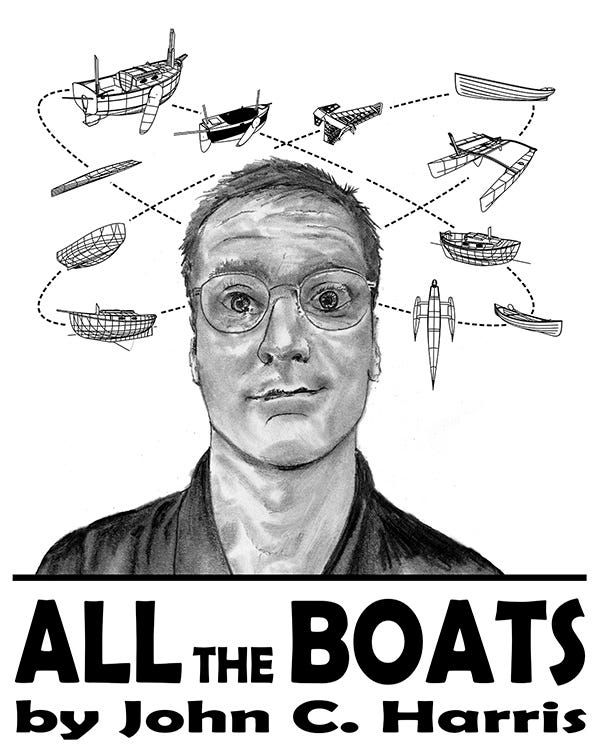13' 6" Tinkerbelle
by John C. Harris "This is the first of a series on tiny ocean-crossing sailboats..."
This is the first of a series on tiny ocean-crossing sailboats. My interest in the type was triggered by the discovery of Robert Manry’s book, Tinkerbelle, while I was in elementary school. No doubt you have read the book; it is one of the most enchanting small boat narratives in print. While not the smallest boat to make an Atlantic crossing at the time, Manry’s 1965 voyage in the 13'6" Tinkerbelle whetted the appetite for ever more ambitious (some would say ludicrous) micro-cruising adventures.
In Manry’s wake, a flotilla of dinghy-sized boats went to sea. Some skippers built cruising machines of intricate design and made meticulous preparations. In haste to seize a record or sell books, others nailed a deck onto an innocent little yacht tender, surviving on cigarettes and sardines. Much of this activity has the feel of performance art, not seamanship. “Capsule boats,” as the writer William Longyard dubbed them, are the seagoing equivalent of the barrel in which one is flung over Niagara Falls.
Nevertheless, I enjoy pondering the challenge of designing a tiny ocean-crosser that actually sails, keeps her crew safe and well-fed, and above all does not become a menace to shipping or a liability for rescue crews. How does Tinkerbelle rank, given that criteria?
Tinkerbelle is, of course, an Old Town Canoe Co. “Whitecap,” a plucky and old-fashioned lapstrake daysailer that Robert Manry acquired for $160. Manry had woodworking skills and cruising ambitions. In the course of several retro-mods his Whitecap acquired a self-bailing cockpit and the distinctive curved coach roof. The visual effect is of a 24-foot cruising auxiliary that has shrunk in the wash. Tinkerbelle is neat, handsome, and, heaven forfend, “cute.” This layout—tiny deckhouse amidships, tiny cockpit right aft—has been widely copied in production trailersailers and do-it-yourself boat plans. I would give Tinkerbelle an A for execution but a D- for functionality.
Stay with me, here. My gripe arises from the fact that the layout of a larger cruiser doesn’t scale down well. The crew’s weight, stuffed so far aft in a 13'6" hull, makes the transom drag and the cockpit flood through the drains. The coamings, placed well inboard, make it hard to sit to windward to counter heeling. The cockpit is too small to sleep in. Down below, the miniature coach with side decks eliminates the best seating position: athwartships with your back against the side of the hull. As far as I know, once Tinkerbelle was stuffed with stores, there was no room to sleep lying down!
From my armchair, I would have instead increased Tinkerbelle’s freeboard by adding a couple more strakes, and given her a flush deck. This would multiply the interior volume, increase reserve stability, and help keep the crew dry. I would have eliminated the cockpit—awash any time the sea is up—and conn the ship from below, sitting in a hatch that could be sealed in bad weather.
Talk of practicalities ruins the fun, I know, but I’d be remiss not to comment on the economy of “capsule boats.” Frugality was a motivation for Manry, and the market wasn’t glutted with used boats back then. So I’ll buy the idea of Tinkerbelle as an affordable solution. In 2022, not so much. Running the inflation calculator, Manry’s outlay in 1965 for Tinkerbelle’s modifications and outfitting comes to about $15,000 today. For that you could acquire an old Cal 20 and undertake an extensive refit. You’ll lose the cachet of having made an Atlantic crossing in a 13-footer, but you won’t be nearly as wet and miserable




I have been fascinated with small boat voyages since youth. I live near Tinkerbelle and need to go check her out soon.
I’m building a 14’ Paradox currently which I’d like to do a noteworthy voyage with.